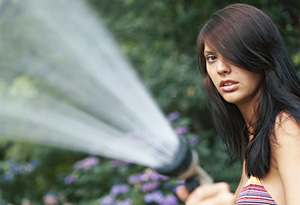Water-Saving Tips for Your Lawn and Garden

Photo: David De Lossy/Thinkstock
With the season's dry air and unforgiving heat, watering is an essential part of summer. But are you wasting precious time, money and resources to keep your yard healthy? Learn how to be water-wise with these tips from home improvement expert Tom Kraeutler.
According to the Environmental Protection Agency (EPA), watering your lawn or garden is estimated to account for almost one-third of all residential water use, totaling more than 7 billion gallons per day.Lawn watering experts at Toro also estimate that up to 50 percent of water used for lawn and garden watering may be lost due to overwatering, evaporation or bad irrigation system design/maintenance. That adds up to a lot of wasted water, which is not good for the planet or your family water budget!
Fortunately, being water-wise doesn't have to be difficult, time-consuming or expensive. There are lots of things you can do to conserve water right in your own backyard.
- Make sure you're watering early in the morning to reduce evaporation. (Before 6 a.m. is best if your city regulations allow.)
- Recycle your grass clippings back into your lawn by using a mulching mower. You'll not only conserve water, but you'll save time while mowing.
- If you are planning a new landscape, consider a water-conserving landscape design that uses drought-tolerant plants native to your climate to reduce watering needs.
- Put a layer of mulch around your plants to retain moisture. A generous amount of 3 to 5 inches is best.
- If you use a hose and portable sprinkler, purchase a hose end timer to regulate your water use.
- Sweep your sidewalks and driveway rather than hosing them down.
- When you're washing your car, turn the hose off between rinses.
- Consider harvesting rainwater with your own rainwater collection system. Compact and easy to assemble, modern rainwater collection systems are great resources for your non-potable water needs and can help trim typically high water bills during the summer months.
- Install drip irrigation systems around your shrubs, hanging baskets and flower and vegetable gardens. Delivering water right to the plant roots is the most efficient way to conserve. Drip irrigation uses up to 70 percent less water than conventional sprinklers.
- Install a home irrigation system. Watering efficiently, and only when your plants and lawn need it, can save a great deal of water.
- Make sure your irrigation system has a rain sensor that shuts off the watering program when it rains. Also, check the alignment of sprinkler heads once a season to make sure you are not watering your sidewalk!
- When planning your lawn watering schedule, think longer, infrequent run times. Deep watering less often promotes good root growth.
- Know your soil type. Different types of soil have different watering needs.
- Raise the blade on your lawn mower. Closely cut grass requires more water.
- Don't fertilize during hot, dry weather—applying fertilizer can enhance drought problems. When you do feed your lawn and garden, use a slow-release fertilizer.
- Know and follow the watering restrictions in your community.
More from Tom Kraeutler






